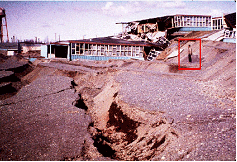 The U.S. Army Corps of Engineers is one of the primary federal agencies assisting state and local governments in protecting the public from natural and manmade emergencies.
The U.S. Army Corps of Engineers is one of the primary federal agencies assisting state and local governments in protecting the public from natural and manmade emergencies.
For floods, the Corps is the lead federal response agency. Flood response activities are authorized under Public Law 84-99, and we can provide either technical assistance or direct assistance. Financial assistance is not provided under this law.
The Corps is also one of the primary agencies helping the Federal Emergency Management Agency in responding to the full range of major disaster and emergency events.
The general principle is that emergency situations are handled at the lowest possible level.
Individuals and families need to take appropriate steps to protect themselves, including developing and maintaining an emergency communications plan and a disaster supplies kit.
Local governments have the primary responsibility for responding to emergency situations. When a situation reaches beyond local capabilities, Alaskan communities request assistance from the Alaska Division of Homeland Security and Emergency Management, part of Alaska's Department of Military and Veterans Affairs.
For pending and current flooding, the Division of Homeland Security and Emergency Management can request assistance from the Alaska District. The Corps can also assist in repairing eligible flood control works that sustain major damage during a flood or coastal storm.
For other disaster assistance that is beyond the state’s capabilities, the governor of Alaska can request that the U.S. president issue a major disaster declaration or an emergency declaration, which allows FEMA to provide assistance.
For serious events, the federal government may implement the National Response Framework, which provides for a wide range of direct assistance to impacted communities. Under the national response plan, the Corps of Engineers is the primary agency for public works and Engineering, Emergency Support Function No. 3.
The greatest disaster threat in Alaska is from a severe earthquake in the Anchorage area. Geologists have determined that shallow faults in the Anchorage area could produce much stronger shaking than occurred during the 1964 Southcentral Alaska Earthquake. Such an earthquake would leave the community without heat, which could result in extensive loss of life during the winter.
To prepare for such an event, the Alaska District and Pacific Ocean Division developed the Catastrophic Disaster Response Plan (CDRP) for an Anchorage earthquake. This plan describes how the Corps would provide immediate assistance to help the residents of Anchorage and also coordinates the activities of the Corps with those of other agencies to prioritize the flow of personnel and supplies.
Just as the CDRP calls for Corps offices from throughout the nation to assist us with a major earthquake in Alaska, the Alaska District provides assistance to any other Corps district that is facing a severe event. In 2017 and 2018, many Alaska District employees deployed to the U.S. Virgin Islands, Puerto Rico, Florida and Texas to help respond to Hurricanes Harvey, Irma, Maria as well as to California for wildfire relief. Several employees from the Alaska District assisted reconstruction efforts in Afghanistan and Iraq.
Other potential threats in Alaska can include avalanches, mudslides, tsunamis, volcanic eruptions, extreme weather conditions and wildfires.